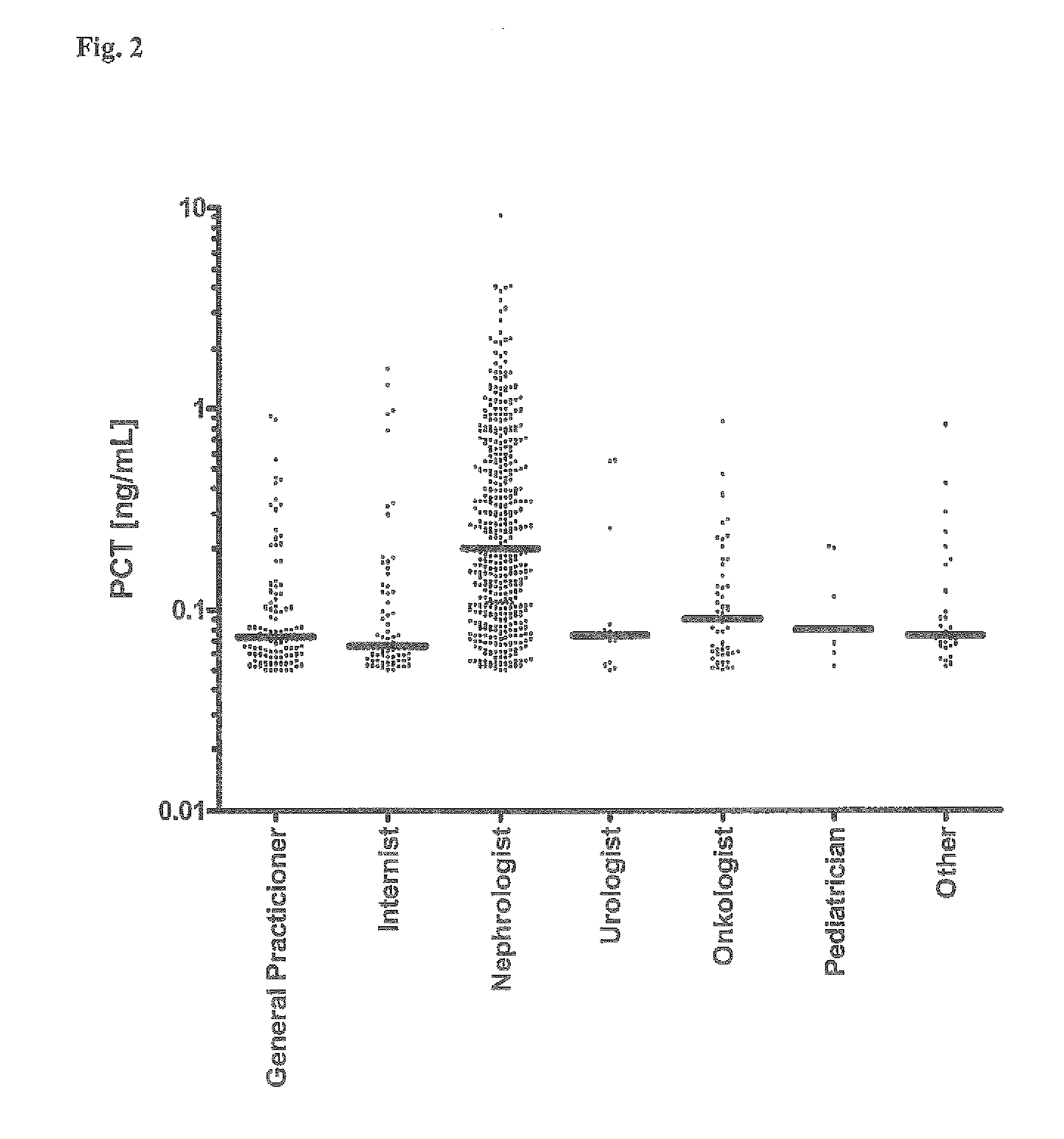Use of Procalcitonin (PCT) in Risk Stratification and Prognosis of Patients with a Primary, Non-Infectious Disease
a non-infectious disease, risk stratification and prognosis technology, applied in the direction of instruments, peptide/protein ingredients, antibacterial agents, etc., can solve the problem of unfavorable clinical outcome from the control group, achieve the effect of facilitating, accelerating and/or enhancing the risk of contracting or acquiring, and elevating the level of procalcitonin (pct)
- Summary
- Abstract
- Description
- Claims
- Application Information
AI Technical Summary
Benefits of technology
Problems solved by technology
Method used
Image
Examples
example 1
Determination of Procalcitonin Levels in Samples of Patients with Various Primary Diseases
[0061]4997 consecutive blood sera samples of patients of a clinical lab have been analyzed to determine the level of procalcitonin (PCT) using the B.R.A.H.M.S PCT sensitive LIA (Luminescence Immuno Assay) Kit (B.R.A.H.M.S AG, Hennigsdorf, Germany, Product No. 109.050). The patients sera have been sent for analysis to the lab by different consulting specialist physicians from various medical fields, such as nephrology, urology, oncology, pediatrics, internal medicine, general medicine and others. The assay has been performed according to the manual shipped with the kit, except that the sample volume has been increased form 50 μL to 100 μL to increase the functional assay sensitivity (FAS) and to reliably determine the PCT concentrations in the lower concentration range (0.05 to 0.25 ng / mL).
[0062]The frequencies of the deteAntined PCT levels have been plotted in a histogram (see appended FIG. 1)....
example 2
General Procedure for the Determination of Procalcitonin Levels in Samples of Patients.
[0064]Procalcitonin (PCT) can be measured as described (Morgenthaler N G et al,: Clin Chem, 2002 May, 48(5), 788-790), Sheep antibodies were raised against the calcitonin moiety of PCT, and a mouse monoclonal antibody was raised against the katacalcin moiety of PCT, Tubes were coated with the anti-katacalc-in antibody. The anti-Calcitonin antibody was labelled with MACN Acridiniumester (InVent GmbH, Hennigsdorf, Germany) and served as tracer, Dilutions of recombinant PCT in normal horse serum served as standards. 100 μl sample or standard were incubated in the coated tubes for 30 minutes, 200 μl tracer were added. After incubation for 2 h the tubes were washed 4 times with 1 ml of LIA wash solution (B.R.A.H.M.S AG), and bound. Chemiluminescence was measured using a LB952T luminometer (Berthold, Germany).
PUM
| Property | Measurement | Unit |
|---|---|---|
| Time | aaaaa | aaaaa |
| Time | aaaaa | aaaaa |
| Time | aaaaa | aaaaa |
Abstract
Description
Claims
Application Information
 Login to View More
Login to View More - R&D
- Intellectual Property
- Life Sciences
- Materials
- Tech Scout
- Unparalleled Data Quality
- Higher Quality Content
- 60% Fewer Hallucinations
Browse by: Latest US Patents, China's latest patents, Technical Efficacy Thesaurus, Application Domain, Technology Topic, Popular Technical Reports.
© 2025 PatSnap. All rights reserved.Legal|Privacy policy|Modern Slavery Act Transparency Statement|Sitemap|About US| Contact US: help@patsnap.com


